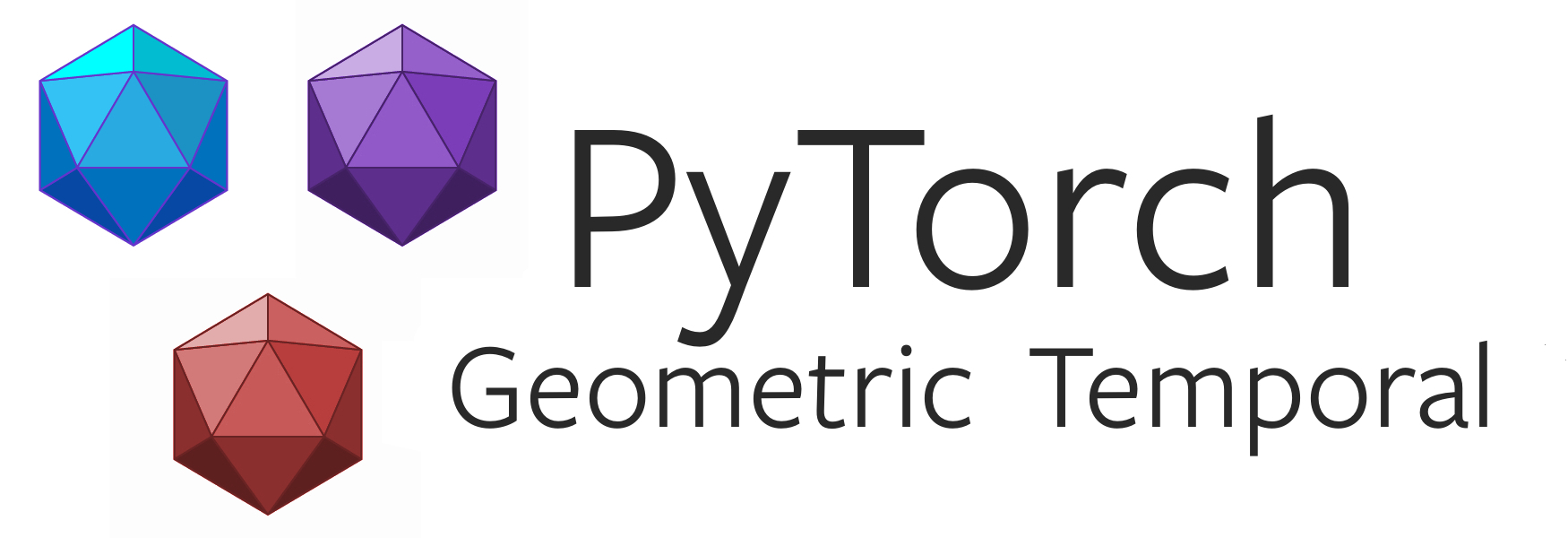Documentation | External Resources | Datasets
PyTorch Geometric Temporal is a temporal (dynamic) extension library for PyTorch Geometric.
The library consists of various dynamic and temporal geometric deep learning, embedding, and spatio-temporal regression methods from a variety of published research papers. In addition, it consists of an easy-to-use dataset loader and iterator for dynamic and temporal graphs, gpu-support. It also comes with a number of benchmark datasets with temporal and dynamic graphs (you can also create your own datasets).
Citing
If you find PyTorch Geometric Temporal and the new datasets useful in your research, please consider adding the following citation:
@misc{pytorch_geometric_temporal,
author = {Benedek, Rozemberczki and Paul, Scherer},
title = {{PyTorch Geometric Temporal}},
year = {2020},
publisher = {GitHub},
journal = {GitHub repository},
howpublished = {\url{https://github.com/benedekrozemberczki/pytorch_geometric_temporal}},
}
A simple example
PyTorch Geometric Temporal makes implementing Dynamic and Temporal Graph Neural Networks quite easy - see the accompanying tutorial. For example, this is all it takes to implement a recurrent graph convolutional network with two consecutive graph convolutional GRU cells and a linear layer:
import torch
import torch.nn.functional as F
from torch_geometric_temporal.nn.recurrent import GConvGRU
class RecurrentGCN(torch.nn.Module):
def __init__(self, node_features, num_classes):
super(RecurrentGCN, self).__init__()
self.recurrent_1 = GConvGRU(node_features, 32, 5)
self.recurrent_2 = GConvGRU(32, 16, 5)
self.linear = torch.nn.Linear(16, num_classes)
def forward(self, x, edge_index, edge_weight):
x = self.recurrent_1(x, edge_index, edge_weight)
x = F.relu(x)
x = F.dropout(x, training=self.training)
x = self.recurrent_2(x, edge_index, edge_weight)
x = F.relu(x)
x = F.dropout(x, training=self.training)
x = self.linear(x)
return F.log_softmax(x, dim=1)
Methods Included
In detail, the following temporal graph neural networks were implemented.
Discrete Recurrent Graph Convolutions
-
DCRNN from Li et al.: Diffusion Convolutional Recurrent Neural Network: Data-Driven Traffic Forecasting (ICLR 2018)
-
GConvGRU from Seo et al.: Structured Sequence Modeling with Graph Convolutional Recurrent Networks (ICONIP 2018)
-
GConvLSTM from Seo et al.: Structured Sequence Modeling with Graph Convolutional Recurrent Networks (ICONIP 2018)
-
GC-LSTM from Chen et al.: GC-LSTM: Graph Convolution Embedded LSTM for Dynamic Link Prediction (CoRR 2018)
-
LRGCN from Li et al.: Predicting Path Failure In Time-Evolving Graphs (KDD 2019)
-
DyGrEncoder from Taheri et al.: Learning to Represent the Evolution of Dynamic Graphs with Recurrent Models (WWW 2019)
-
EvolveGCNH from Pareja et al.: EvolveGCN: Evolving Graph Convolutional Networks for Dynamic Graphs (AAAI 2020)
-
EvolveGCNO from Pareja et al.: EvolveGCN: Evolving Graph Convolutional Networks for Dynamic Graphs (AAAI 2020)
Temporal Graph Convolutions
- STGCN from Yu et al.: Spatio-Temporal Graph Convolutional Networks: A Deep Learning Framework for Traffic Forecasting (IJCAI 2018)
Auxiliary Graph Convolutions
-
TemporalConv from Yu et al.: Spatio-Temporal Graph Convolutional Networks: A Deep Learning Framework for Traffic Forecasting (IJCAI 2018)
-
DConv from Li et al.: Diffusion Convolutional Recurrent Neural Network: Data-Driven Traffic Forecasting (ICLR 2018)
Head over to our documentation to find out more about installation, creation of datasets and a full list of implemented methods and available datasets. For a quick start, check out the examples in the examples/ directory.
If you notice anything unexpected, please open an issue. If you are missing a specific method, feel free to open a feature request.
Installation
PyTorch 1.7.0
To install the binaries for PyTorch 1.7.0, simply run
$ pip install torch-scatter==latest+${CUDA} -f https://pytorch-geometric.com/whl/torch-1.7.0.html
$ pip install torch-sparse==latest+${CUDA} -f https://pytorch-geometric.com/whl/torch-1.7.0.html
$ pip install torch-cluster==latest+${CUDA} -f https://pytorch-geometric.com/whl/torch-1.7.0.html
$ pip install torch-spline-conv==latest+${CUDA} -f https://pytorch-geometric.com/whl/torch-1.7.0.html
$ pip install torch-geometric
$ pip install torch-geometric-temporal
where ${CUDA} should be replaced by either cpu, cu92, cu101, cu102 or cu110 depending on your PyTorch installation.
cpu |
cu92 |
cu101 |
cu102 |
cu110 |
|
|---|---|---|---|---|---|
| Linux |
|
|
|
|
|
| Windows |
|
|
|
|
|
| macOS |
|
PyTorch 1.6.0
To install the binaries for PyTorch 1.6.0, simply run
$ pip install torch-scatter==latest+${CUDA} -f https://pytorch-geometric.com/whl/torch-1.6.0.html
$ pip install torch-sparse==latest+${CUDA} -f https://pytorch-geometric.com/whl/torch-1.6.0.html
$ pip install torch-cluster==latest+${CUDA} -f https://pytorch-geometric.com/whl/torch-1.6.0.html
$ pip install torch-spline-conv==latest+${CUDA} -f https://pytorch-geometric.com/whl/torch-1.6.0.html
$ pip install torch-geometric
$ pip install torch-geometric-temporal
where ${CUDA} should be replaced by either cpu, cu92, cu101 or cu102 depending on your PyTorch installation.
cpu |
cu92 |
cu101 |
cu102 |
|
|---|---|---|---|---|
| Linux |
|
|
|
|
| Windows |
|
|
|
|
| macOS |
|
Running tests
$ python setup.py test
Running examples
$ cd examples
$ python gconvgru_example.py
License


 and the original source code:
https://github.com/lehaifeng/T-GCN/blob/e21fb99a5c56fdf667a4ff7a9c8236761f7377f8/A3T-GCN/A3T-GCN.py#L90-L109
and the original source code:
https://github.com/lehaifeng/T-GCN/blob/e21fb99a5c56fdf667a4ff7a9c8236761f7377f8/A3T-GCN/A3T-GCN.py#L90-L109